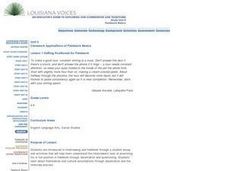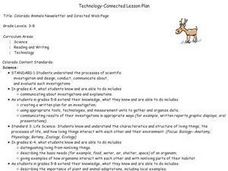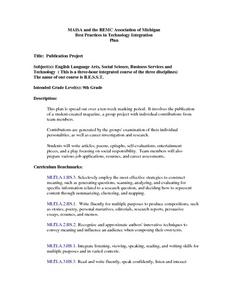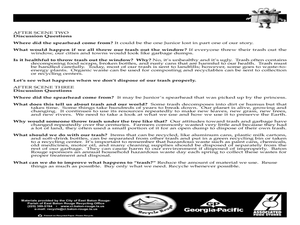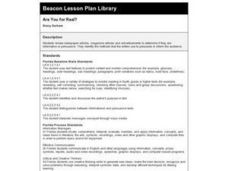Curated OER
My Secret War: The WWII Diary of Madeline Beck: Lesson 11
Fifth graders explore world history by participating in a class game. In this propaganda instructional activity, 5th graders identify Madeline Beck and the role women played during World War II. Students create fictitious propaganda...
Curated OER
Cloud in the Classroom
Students describe the relationship between animals and humans. For this biology lesson, students research about the history of horses in America. They present a mock news broadcast about their research.
Curated OER
The Family: Louisiana Family Folklore
Students explore and identify family treasures and research the history to each one. They also organize a variety of artifacts into various categories and research traditional Louisiana artifacts online. Each student draws inferences...
Curated OER
Tall Tales and Urban Legends
Students identify and interpret what tall tales, urban legends, and cyberlore are and to find them in their own lives. They practice telling and listening to these types of tales and explore why people tell them. Students also identify...
Curated OER
Revolutionary War
Students identify and research significant people, causes, and primary documents of the U.S. Revolutionary War. They create a class Revolutionary War web using Inspiration computer software, write a journal depicting three days in the...
Curated OER
Getting Positioned for Fieldwork
Students examine interviewing and fieldwork through a student essay and activities that help them understand the interviewer's task of examining his or her position in fieldwork through observation and questioning. They explore cultural...
Curated OER
Newsworthy Fairy Tales
Third graders review common fairy tales and work in teams to rewrite the fairy tales as news articles. They answer questions using the 5 Ws (who, what, where, when, why). Student articles include eye-catching headlines.
Curated OER
Our Zoo Friends
First graders plan and create a model zoo depicting the natural habitats of animals. Their models include animals and a display of written factual information about the animals. Students present their project by conductig a tour of...
Curated OER
It's Just a Barn
Investigate Pennsylvania Barns. Have your class consider the elements common to Pennsylvanian barns and why they are significant to the food production process. They write summaries of Frederick Watts and his impact on agriculture.
Curated OER
Colorado Animals Newsletter and Directed Web Page
Students select a Colorado animal, develop a Directed Web page, and research their animal. Each member of the group combine their research and develop a Newsletter.
Curated OER
Publication Project
Ninth graders publish a magazine during a ten week marking period. They make individual contributions to the group project that is based on career choices. They write and publish articles, poems, entertainment pieces, and a play that...
Curated OER
Animal Science Research Report
Students research an animal. In this research lesson, students utilize various types of technology to gather information about an animal. Students create a class blog and use digital photography for their research.
Curated OER
Fitting Trash into Yesterday: A Fifth Grade Activity
Fifth graders explore the concept of waste management. In this recycling lesson, 5th graders discover the history of waste management and discuss how the U.S. should respond to the issue of ever-increasing waste.
Curated OER
Killer Wrapper
Students examine the importance of food safety and the impact it has on their lives. In this health lesson students complete an oral report on food poisoning and design a low cost "safe" packing material for bread.
Curated OER
Are You For Real?
Students try to find newspaper and magazine articles that are informative or persuasive. They practice determining the differences between the two types of articles. They identify the devices authors use to persuade the audience.
Curated OER
Picture Dictionary
Students write and contribute one page for a class picture dictionary. They discuss how to alphabetize words, and examine both regular and picture dictionaries and how they are organized. Next they create a page for the class dictionary...
Curated OER
Genre Study - Grade Three
Third graders learn to identify different types of literature genres. In this genre lesson, 3rd graders complete pre and post- assessment, conduct a genre research activity, and complete the associated worksheets.
Curated OER
Mystery Research Unit
Seventh graders participate in a "Solve the Media Center Mystery" using the directions that are included in the lesson. They role play as detectives as complete the activity and choose a research topic. They develop questions that they...
Curated OER
No Title
Fourth graders identify the characteristics of a good paragraph and find those characteristics in a good paragraph from the books, "One Day in the Woods," by Jean Craighead George and "Why Do Leaves Change Color," by Betsy Maestro.
Curated OER
Discover the Planets
Third graders research the planets. In this science lesson, 3rd graders create PowerPoint presentations over a planet. Students present their findings.
Curated OER
European Union And Its Organizations
Tenth graders investigate the historical events surrounding the founding of the European Union. The teacher provides a handout to guide the instructional activity and research. They answer questions verbally in the form of a class...
Curated OER
Ancient Roman Monuments and Timeline
While a terrific idea, this instructional activity in which learners create a timeline showing the date that a variety of buildings and monuments were built in Ancient Rome, requires resources teachers may not have. It requires the use...
Curated OER
Black History Month
Students work in cooperative pairs to research information and give oral presentations about African American men and women who have made significant contributions to U.S. history.
Curated OER
Writing Original Directions
Third graders create original design directions. Each student creates a design and composes directions for re-creating it. Then, when students form pairs, they take turns drawing from one another's written directions.





